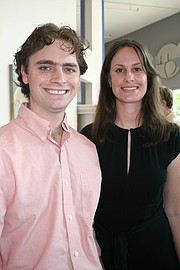Based on information provided by the State Department of Elementary and Secondary Education, Fulton Public Schools, Superintendent Jacque Cowherd said Wednesday he overestimated gaming revenue for this year by about $90,000.
Cowherd said he increased the expected income from the Missouri Classroom Trust Fund by about $90,000 for the 2010-11 school year. The Classroom Trust Fund is financed mainly from casino gambling and Missouri Lottery revenue.
But he said monthly distributions have not reflected the expected increase.
"It obviously was too high," Cowherd said.
Roger Dorson, coordinator of school finances and administrative services for the Missouri Department of Elementary and Secondary Education, said his department overestimated gaming revenue from casinos because it had anticipated a big increase based on removal of the $500 loss limit in casinos.
"But that extra money did not materialize. We had estimated $383,468,473 in Classroom Trust Fund money would be available for the current fiscal year ending June 30. But the state budget office says revenue is not coming in with the increases we had estimated. About a month ago the revenue estimate of $383,468,473 has been lowered by $23,808,000," Dorson said.
Dorson said even though the Fulton School District is receiving less state aid than expected from the Classroom Trust Fund funded mainly by casino revenue, the shortfall will be made up in extra aid from the State School Foundation Program to make up for that shortfall.
Dorson said all but $12 million of the $383.5 million Missouri Classroom Trust Fund comes from casino gambling revenue. The $12 million comes from unclaimed Missouri Lottery tickets.
Including the Classroom Trust Fund contribution of $12 million, the Missouri Lottery contributed $255 million to Missouri's public education and casino gambling added another $371 million more to public education.
Cowherd said he now is estimating gaming revenue from the state to the Fulton School District at $744,000 for the 2011 fiscal year, which is about the same amount received last year with no decrease in funding from this revenue source.
He said when the budget was prepared he had estimated gaming income to the district of about $834,000, which is about $90,000 higher than last year's gaming income to the district.
Cowherd said in 2010 gaming revenue to the Fulton School District was $743,622 and he blamed faulty state guidance for adding $90,000 to that figure.
He said since the recession gaming revenue has been declining. In 2009 gaming revenue to the Fulton School District was $762,051. It was $782,808 in 2008.
He said gaming aid is apportioned to each school district from state gaming revenue based on a flat amount for each student enrolled.
"Our enrollment in the Fulton School District has been declining in recent years and this adds to the loss in gaming revenue," Cowherd said.
Since 2008, annual state gaming aid per student has been declining. Per student gaming aid in 2008 was $362.38; in 2009, $361.36; in 2010, $359.82; and in 2011 it is projected to fall to $359.00.
All school districts statewide share in the same amount of gaming aid based on average daily attendance or per student aid.
Other school districts in Callaway County have the same percentage of state gaming aid based on student enrollment.
The Missouri Department of Elementary and Secondary Education reports 2009-2010 state gaming aid from the Missouri Classroom Trust Fund to Callaway County School Districts as follows:
Fulton School District, $743,622.
North Callaway School District, $456,811.
South Callaway School District, $303,048.
New Bloomfield School District, $246,952.
All casino gaming revenue goes to education except for 2 percent of adjusted gross revenue that goes to cities with casinos. All Missouri Lottery proceeds also are earmarked for education.
Unlike the state owned Lottery, Missouri casinos are privately owned and pay taxes to the state based on adjusted gross receipts. The state of Missouri receives gaming taxes equal to 19 percent of the casino's adjusted gross receipts. Cities where casinos are located receive 2 percent of AGR. State and local city governments with casinos each receive $1 in admissions tax for every casino visit.
Missouri casinos generated more than $367 million in state and local gaming tax revenue and nearly $108 million in admission fees.
Casino revenue increased a little under 2 percent in 2007, just over 2 percent in 2008, and jumped up 4 percent in 2009 but fell to a 2.5 percent increase in 2010.
The big jump in 2009 came after Illinois instituted a smoking ban for all casinos in the state. This resulted in an increase in revenue for Missouri, Iowa and Indiana casinos from Illinois residents traveling across the boarder to neighboring states where smoking was allowed. The St. Louis Federal Reserve estimated a $61 million loss to Illinois gaming revenue because of the smoking ban. This resulted in a 9 percent gaming revenue gain in Missouri markets close to the Illinois line.
In addition to the Illinois legislation, Missouri voters repealed the two-hour $500 loss limit in November 2008. This helped sustain the gains made by the smoking ban starting in 2008 and helped generate statewide gains in fiscal year 2009 of more than 4 percent, even though that was a recession year.
Currently, Missouri school districts receive more than $3 billion per year through the state school foundation formula.
In 2010, the Missouri Lottery contributed $255 million to public education. Much of the Lottery's contribution to education comes through the School Foundation Formula, not through the Classroom Trust Fund. Only about $12 million in unclaimed lottery tickets goes to the Classroom Trust Fund. All of the other money in that fund comes from casino gambling.
Since 1994, all Lottery revenue has been earmarked for public education. Of every dollar spent on the Missouri Lottery, 26.6 cents goes to support public education; 63.4 cents goes back to players as prizes, 3.8 cents is used for administrative costs and promotion, and 6.2 cents goes to retailers in the form of commissions, incentives and bonuses. In all, more than 96 cents of every dollar stays in Missouri.
Even though some state school aid has been trimmed, aid from the Missouri Lottery still flows directly to schools throughout the state.
For the school year 2009-10 the Missouri Lottery sent $986,162 to Callaway County schools.
That includes $793,260 for Callaway County public elementary and high schools, most of it in the form of aid for bus transportation.
Callaway County elementary and high schools in 2010 received $657,668 from the Missouri Lottery for transportation through the state's Foundation Transportation fund.
From the Missouri Lottery last year, Callaway County schools received $65,886 based on average daily attendance, $61,538 for early special education, $7,814 in aid to clients with disabilities to help them obtain employment.
In addition to aid to elementary and secondary education, Callaway County students attending college at various colleges and universities in Missouri received $190,902 in Access Missouri scholarships paid for by the Missouri Lottery and another $2,000 in minority teacher scholarships.
All proceeds from Missouri Lottery ticket sales went to the state's general revenue fund when the lottery was started in 1986. But six years later Missouri voters passed a constitutional amendment earmarking lottery proceeds to benefit only education.
Each year the Missouri legislature determines how lottery proceeds will be allocated. It goes to public elementary, high school and college education throughout the state.
During the 25 years the Missouri Lottery has been in operation, it has contributed more than $3.8 billion to the state of Missouri and public education. Annual lottery contributions comprise about 4 percent of total spending for education in Missouri.
For fiscal year 2011, more than $271 million from Lottery proceeds have been appropriated for education programs in Missouri.
The lottery this year will contribute $117.9 million to the state aid to local schools program under the Foundation Program
High schools in Missouri designated as A+ Schools that meet certain standards received $21.7 million in 2011 from the Missouri Lottery. The lottery funds 97 percent of the total A+ school funding in Missouri. Students who graduate from a designated A+ School may qualify for state-paid assistance to attend any eligible public community college or technical school in the state.
The Missouri Lottery in 2011 will contribute $12 million in Access Missouri scholarships to Missouri students attending colleges in Missouri based on financial need and academic achievement.
In Callaway County last year the Missouri Lottery contributed $986,162 to local schools, $484,831 to county retailers selling lottery tickets and $4.7 million to Callaway County residents who won lottery prizes.
During the 2011 fiscal year the Missouri Lottery also helps fund the state's public colleges and universities directly with lottery money.
The University of Missouri's four campuses received $36.9 million, or 9 percent of its entire budget, from the Missouri Lottery.
The amounts received from the Missouri Lottery and the percent of their total annual budget for other public higher education institutions in Missouri are:
• Lincoln University in Jefferson City, $1.55 million, 8 percent.
• Missouri State University in Springfield, $7.7 million, 9 percent.
• University of Central Missouri at Warrensburg, $5 million, 9 percent.
• Southeast Missouri State University at Cape Girardeau, $4.1 million, 9 percent.
• Truman State University at Kirksville, $3.8 million, 9 percent.
• Northwest Missouri State University at Maryville, $2.6 million, 8 percent.
• Missouri Southern State University at Joplin, $2 million, 8 percent.
• Missouri Western State University at St. Joseph, $2 million.
• Harris-Stowe State University at St. Louis, $909,000, 9 percent.
• Linn State Technical College at Linn, $421,000, 8 percent.


